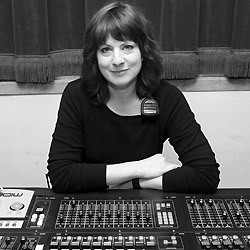
Choosing Platforms
When Sabolchick and I recently caught up via phone, she’d just returned to her home in Scranton, PA, after touring, alternately, with Styx and Mr. Big (a band she’s mixed since 2009).
She’s been full time with Styx since July 2015, but also worked with them briefly in 2013. That initial stint was to fill in for the band’s long-time live and recording engineer – Gary Loizzo, owner of Pumpkin Studios – who passed away in early 2016 after a lengthy battle with pancreatic cancer.
When Sabolchick took the Styx gig she was working on a Yamaha PM5D console, noting, “Gary had one for years and, because they do over a hundred shows a year – going out for several weeks, coming home for a week, then going out again – they don’t rehearse, because they’re constantly touring.”
Ultimately, Sabolchick switched to a Midas Pro X digital board when the band was prepping for a gig in Las Vegas in 2015. Still, she describes herself as an “analog girl” who’d prefer that approach with Styx. “I’d actually still have an (Midas) XL4, but we can’t fit it in the truck,” she says. “I love analog, and with Styx it’s a crazy mix intensive show.
“For instance,” she continues, “at the top of ‘Lady,’ I’ve got four vocals, a little chime mic that’s got to be cranked, and a keyboard part. When the song kicks in after the first verse I have to mute the chime mic, mix a four-part harmony, and I’ve also got the lead singer switching to an RF mic from a hardwired mic in the middle of a line and all that’s happening in a split second. On a more straightforward show, where you don’t have a lot of cues, it’s one thing; you kind of set it and forget it. But with a lot of the bands I mix there are a lot of changes throughout the night and a lot of things to think about.”
With Styx or any mix intensive show, she adds: “There’s so much going on that, with digital, it can be difficult at times. I have to do a lot of thinking: ‘How am I going to lay out the board?’ It takes a lot of thought as far as workflow, efficiency and getting at what I need to as quickly as possible. With analog, there’s no scrolling through pages. You just grab what you need when you need it. It’s all right there in front of you.”
Sabolchick’s happy to roll with the times, and while she doesn’t mince words when it comes to her preference the warm, fat sound of consoles from back in the day, she does admit digital consoles have become significantly better over time. “That’s why I’m on the Midas now. I think it’s one of the best sounding digital consoles out there, and if you start with the right tool, you shouldn’t need $5,000 worth of plugins to make it sound good.”
She also doesn’t miss carrying extra racks, dealing with more patching, and the added potential for buzz and noise floor issues that analog gear entails. “There are definitely pros and cons,” she states. “When I first started using digital I was carrying a rack of Empirical Lab Distressors, TC Electronics reverb and an Eventide H3000. That was my standard rack.”
Ideally, she’d love to use that gear for Styx, but given the lack of truck space it’s not feasible. “Besides,” she adds, “the Pro X can handle all that and I’ve actually found, lately, that trying to integrate analogue outboard gear with digital can create more problems than it’s worth – latency, noise issues – and the Midas compressors sound great, so I don’t miss the outboard gear.”
Key Elements
Regardless of the project, Sabolchick’s preparation begins with going through the artist’s catalog.
“Some, like Melissa Etheridge, have a number of records, others just have a couple, but I start there and when we do rehearsals – if we do rehearsals – I have a conversation with them,” she explains. “Some say, ‘Just mix. Have fun.’ But others have very distinct ideas about what they want. Even if there are no production rehearsals, I try to be in band rehearsals to see what everybody’s got going on because, so often, it’s completely different live than on record.”
On Stefani’s tours, Sabolchick worked closely with the band’s MD/keyboard player, Kris Pooley. “He did incredible arrangements for the show and put it together in a cohesive fashion. With Gwen, the first shows were festivals, kind of throw and go,” she says. “When we did the full tour, we had two or three rehearsals before we a chance to talk and I said, ‘Do you have any suggestions or requests?’ She said, ‘Just make it sound good.’ She hired people she trusted and let you do your job.”
